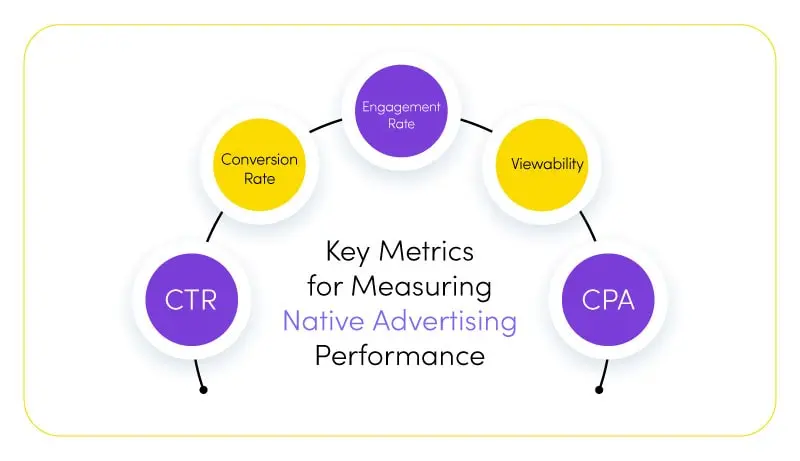Native advertising has become a popular marketing strategy for businesses to reach their target audience. It involves creating content that fits seamlessly into the platform it’s displayed on, such as social media or a website. Measuring the performance of native advertising is crucial to determine its success and ROI. In this article, we’ll discuss how to measure native advertising performance and the importance of doing so.

Key Metrics for Measuring Native Advertising Performance
Native advertising performance can be measured through a variety of metrics that help determine the effectiveness of a campaign. Here are some key metrics to consider when measuring the performance of your native advertising:
- Click-Through Rate (CTR): CTR measures the number of clicks an ad receives per impression. It is an important metric for measuring engagement and audience interest.
- Conversion Rate: Conversion rate measures the number of clicks that result in a desired action, such as a purchase, sign-up, or download. It helps measure the effectiveness of the ad in terms of driving business outcomes.
- Engagement Rate: Engagement rate measures the interaction with an ad beyond clicks, such as likes, shares, and comments. It indicates the level of audience involvement and interest in the ad.
- Viewability: Viewability measures whether an ad was actually seen by the audience. It is important to ensure that the ad is being seen by the target audience to maximize its impact.
- Cost Per Action (CPA): CPA measures the cost of each desired action, such as a purchase or sign-up. It helps determine the return on investment (ROI) of a campaign.

If you want to master how to create a successful native advertising campaign, then you should know tracking and analyzing these metrics can provide insights into the performance of a native advertising campaign, allowing for optimization and improved results.
Common KPIs for Native Advertising
Key performance indicators (KPIs) are essential for measuring the effectiveness of any marketing campaign, including native advertising. Here are some of the most common KPIs for measuring native advertising performance:
- Click-Through Rate (CTR): CTR measures the number of clicks your native ad receives divided by the total number of impressions. It is a good indicator of how many people found your ad compelling enough to click on it.
- Engagement Rate: Engagement rate is the number of social interactions (likes, shares, comments) divided by the total number of impressions. This KPI can help you understand how well your content is resonating with your audience.
- Conversion Rate: Conversion rate measures the number of people who completed a desired action, such as filling out a form or making a purchase, divided by the total number of clicks. It is a crucial metric for determining the ROI of your native advertising campaign.
- Cost Per Click (CPC): CPC measures how much you pay for each click on your native ad. It is a crucial metric for determining the cost-effectiveness of your campaign.
- Return on Investment (ROI): ROI measures the amount of revenue generated by your campaign compared to the cost of running the campaign. This KPI is essential for determining the overall success of your native advertising campaign.

When setting goals and benchmarks for these KPIs, it’s essential to keep in mind your campaign’s overall objectives and target audience. For example, if your primary goal is to increase brand awareness, you might prioritize metrics like CTR and engagement rate. On the other hand, if your goal is to drive sales, you might prioritize metrics like conversion rate and ROI.
Tools for Measuring Native Advertising Performance
Measuring the performance of native advertising campaigns can be challenging, especially when it comes to tracking the right metrics and understanding the impact of your campaigns on your target audience. Fortunately, there are a variety of tools and platforms available that can help you measure the effectiveness of your native advertising campaigns.
- Native Advertising Analytics Tools: Many native advertising platforms offer built-in analytics tools that can help you track and analyze the performance of your campaigns. These tools provide a range of metrics, including impressions, clicks, and conversions, and can help you optimize your campaigns for better results.
- Google Analytics: Google Analytics is a powerful tool that can help you track the performance of your native advertising campaigns, as well as other marketing efforts. By setting up custom tracking codes and goals, you can track the performance of your campaigns across a range of metrics, including traffic, engagement, and conversions.
- Social Media Analytics Tools: If you’re running native advertising campaigns on social media platforms like Facebook or Twitter, you can use their built-in analytics tools to track your campaign performance. These tools provide insights into engagement, clicks, and conversions, and can help you optimize your campaigns for better results.
- Third-Party Analytics Tools: There are also a variety of third-party analytics tools available that can help you measure the effectiveness of your native advertising campaigns. These tools provide a range of metrics and insights, and can help you optimize your campaigns for better results.

When using these tools to measure native advertising performance, it’s important to choose the right metrics that align with your campaign goals and objectives. By tracking and analyzing the right metrics, you can gain valuable insights into the effectiveness of your campaigns, and make data-driven decisions to optimize your campaigns for better results.
Measuring Native Advertising Effectiveness
Measuring the effectiveness of native advertising campaigns is crucial to determine the return on investment (ROI) and optimize future campaigns. Here are some strategies to assess the effectiveness of native advertising:
- Brand Lift: This metric measures the increase in brand awareness, consideration, or perception after exposure to a native ad campaign. Surveys or research studies can be used to measure brand lift.
- Engagement: This metric measures how users interact with native ads. Engagement can be measured by clicks, shares, likes, comments, and other user interactions.
- Conversions: This metric measures the number of desired actions taken by users after viewing a native ad, such as making a purchase or filling out a form.
- ROI: This metric measures the return on investment for a native ad campaign. It takes into account the cost of the campaign and the revenue generated from conversions.

Examples of successful native advertising campaigns and their performance metrics include:
- Airbnb’s partnership with the New York Times resulted in a 50% increase in their brand awareness.
- GE’s native ad campaign on Politico resulted in over 5 million page views and a 50% increase in their brand favorability.
- Dell’s native ad campaign on Forbes resulted in a 60% increase in their content engagement and a 40% increase in their website traffic.
By measuring these metrics and analyzing the results, advertisers can optimize their native advertising campaigns for better performance and ROI.
Conclusion
In conclusion, measuring native advertising performance is crucial for determining the success of your campaigns and optimizing future strategies. By tracking key metrics such as engagement, conversions, and ROI, you can gain valuable insights into the effectiveness of your native ads and make data-driven decisions to improve their performance.
Remember to set clear goals and benchmarks for your KPIs, and use the right tools and platforms to track and analyze your data. Look for patterns and trends in your metrics, and adjust your campaigns accordingly to maximize their impact.
Overall, with the right approach and mindset, you can achieve great success with native advertising. By understanding how to measure native advertising performance, you can stay ahead of the competition and deliver exceptional results for your business.
FAQs
What is the most important metric for measuring native advertising performance?
The most important metric for measuring native advertising performance can vary depending on the campaign goals, but common metrics include engagement rate, click-through rate (CTR), time spent on site, and conversion rate.
How do you track conversions from native advertising campaigns?
To track conversions from native advertising campaigns, you can set up conversion tracking on your website and use tools such as Google Analytics or Facebook Pixel to track user behavior.
Can you measure the impact of native advertising on brand awareness?
Yes, you can measure the impact of native advertising on brand awareness through metrics such as brand lift, sentiment analysis, and social media mentions.
What are some tools for measuring the effectiveness of native advertising?
Some tools for measuring the effectiveness of native advertising include Google Analytics, Facebook Ads Manager, Outbrain Amplify, Taboola, and NativeAI.







 Facebook Ads Spy Tool
Facebook Ads Spy Tool TikTok Ads Spy Tool
TikTok Ads Spy Tool